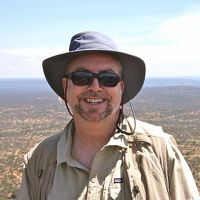Michelotti et al., 2013
Modeling aeolian transport of soil-bound plutonium: considering infrequent but normal environmental disturbances is critical in estimating future dose
Michelotti E.A., Whicker J.J., Eisele W.F., Breshears D.D., Kirchner T.B. (2013)
Journal of Environmental Radioactivity 120: 73-80
-
Catalina-Jemez, INVESTIGATOR
Abstract
Dose assessments typically consider environmental systems as static through time, but environmental disturbances such as drought and fire are normal, albeit infrequent, events that can impact dose-influential attributes of many environmental systems. These phenomena occur over time frames of decades or longer, and are likely to be exacerbated under projected warmer, drier climate. As with other types of dose assessment, the impacts of environmental disturbances are often overlooked when evaluating dose from aeolian transport of radionuclides and other contaminants. Especially lacking are predictions that account for potential changing vegetation cover effects on radionuclide transport over the long time frames required by regulations. A recently developed dynamic wind-transport model that included vegetation succession and environmental disturbance provides more realistic long-term predictability. This study utilized the model to estimate emission rates for aeolian transport, and compare atmospheric dispersion and deposition rates of airborne plutonium-contaminated soil into neighboring areas with and without environmental disturbances. Specifically, the objective of this study was to utilize the model results as input for a widely used dose assessment model (CAP-88). Our case study focused on low levels of residual plutonium found in soils from past operations at Los Alamos National Laboratory (LANL), in Los Alamos, NM, located in the semiarid southwestern USA. Calculations were conducted for different disturbance scenarios based on conditions associated with current climate, and a potential future drier and warmer climate. Known soil and sediment concentrations of plutonium were used to model dispersal and deposition of windblown residual plutonium, as a function of distance and direction. Environmental disturbances that affected vegetation cover included ground fire, crown fire, and drought, with reoccurrence rates for current climate based on site historical patterns. Using site-specific meteorology, accumulation rates of plutonium in soil were modeled in a variety of directions and distances from LANL sources. Model results suggest that without disturbances, areas downwind to the contaminated watershed would accumulate LANL-derived plutonium at a relatively slow rate (<0.01 Bq m-2 yr-1). However, model results under more realistic assumptions that include environmental disturbances show accumulation rates more than an order-of-magnitude faster. More generally, this assessment highlights the broader need in radioecology and environmental health physics to consider infrequent but normal environmental disturbances in longer-term dose assessments.
Citation
Michelotti E.A., Whicker J.J., Eisele W.F., Breshears D.D., Kirchner T.B. (2013): Modeling aeolian transport of soil-bound plutonium: considering infrequent but normal environmental disturbances is critical in estimating future dose. Journal of Environmental Radioactivity 120: 73-80. DOI: 10.1016/j.jenvrad.2013.01.011
 This Paper/Book acknowledges NSF CZO grant support.
This Paper/Book acknowledges NSF CZO grant support.
Explore Further

